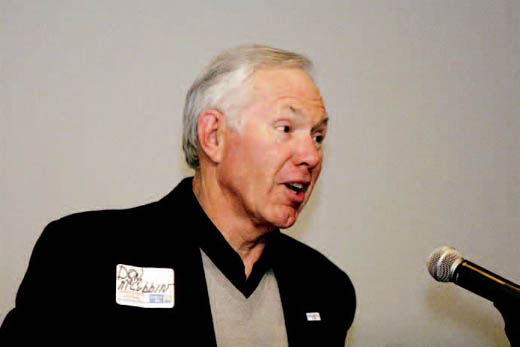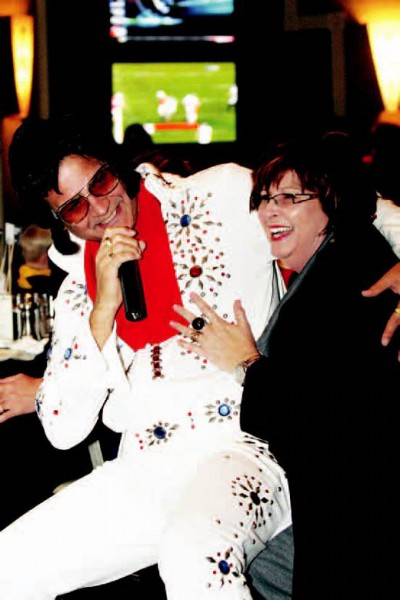Donors dig deeper as needs rise, UW exceeds goal
by Jacob Barker
December 10, 2010

The organization, for the 50th straight year, received more in donations than it did the previous year and expects to exceed its $3.3 million donation goal by $60,000.
“In this economic climate, there’s no doubt you have concerns about (reaching goal),” said Shelter Insurance Executive Vice President Don McCubbin, who chaired the United Way’s 2010 campaign.
The local unemployment rate has been stuck greater than 6 percent, the housing industry continues to falter, and many workers have seen reduced buying power this year.
“But as things began to unfold,” McCubbin said, “we started to see some momentum building.”

Local manufacturers Hubbell Power Systems and Dana Corp ran United Way campaigns for the first time in five years. And fast-growing VAMortgageCenter.com gave the Heart of Missouri United Way the largest-ever donation by a private employer: more than $400,000.
But the increase in giving is matched by a sharp rise in demand for services, local nonprofit organizations report. That follows the national trend. A survey released Nov. 29 by the Nonprofit Research Collaborative found that for the eighth straight year, a majority of the surveyed charities reported increases in the demand for services.
The survey also found that 37 percent of charities reported decreased giving from last year, compared with 36 percent that reported increased giving. But that’s still better than 2009, when 51 percent of charities saw their donations fall.
Local charity directors said the community’s generosity has allowed them to continue increasing the services they provide every year. According to a United Way report for the 2009-2010 campaign year, Columbia per capita donations, at $23, were the fourth-highest in the state, behind Fulton, St. Louis and St. Joseph.
After the financial panic in 2008 took the local United Way by surprise and caused it to miss its fundraising goal that year, the past two years it has reached 101 percent of its goal, Executive Director Tim Rich said.
“That’s very good news in this economy to have essentially two years in a row in a tough economy where we’ve exceeded goal by at least 1 percent,” he said.
After 2008, the agency lowered its fundraising goal for 2009 — the first time it had ever taken such a step. But the 2010 campaign set a goal greater than pre-recession levels, and local donors came through to meet it.

“In one of the toughest economic climates that they have faced, where there’s some real hurt being felt by their own employees, still their employees are concerned enough about their community that they stepped up and gave more,” he said.
Peggy Kirkpatrick, executive director of the Central Missouri Food Bank, said her organization is seeing more volunteers and financial support. Through the entirety of 2009, 22,000 volunteers donated 52,000 volunteer hours to the Food Bank. This year, the organization has already had 23,000 volunteers donate in excess of 55,000 hours of time.
“When times get extremely difficult, organizations that focus on basic needs usually see no downturn, I think.,” Kirkpatrick said.
Although fundraising is down slightly from last year at the Voluntary Action Center, businesses that hadn’t been sponsors in earlier years are stepping forward to help, Project Director Marissa Todd said.
“It’s just nice to have these businesses and entities that we don’t necessarily have an association with actually seek us out,” Todd said.
Although donations are down a bit at the VAC, volunteerism there has risen. The organization has given 116 presentations on volunteering this year, compared with 76 last year, according to Executive Director Cindy Mustard. The number of people who call for information on volunteering or attend a presentation is up to 8,900, compared with 6,900 in 2009.
“When you see harsher economic times, people … who don’t have extra funds are more willing to give some time,” Mustard said.

“It’s off the charts,” Kirkpatrick said.
The largest number of people the Food Bank ever served from its pantry on Big Bear Boulevard was last December, when 10,000 people went there for help.
“June broke December’s record,” Kirkpatrick said. “July broke June’s record. August broke July’s record.” In August, 11,429 people went to the food pantry, making it the busiest month in its history.
“We are seeing people come in, 150 to around 250 new families each month, that have never been to a food pantry before in their entire lives,” Kirkpatrick said.
Those numbers dwarf those of past years, when the Food Bank would serve around 200 to 300 new families each year.
Mustard said that the VAC, too, has seen more new people seeking aid.
“One of the big things we’ve seen is we have a 24 percent increase of people coming to us who have never been here before,” she said.
Although private donations have been able to sustain charities, those that depend on public funding are trying to retain their levels of service and bracing for further cuts from the state.
“All of our state funding has taken a hit,” said Christine White, the Columbia director of Lutheran Family and Children’s Services of Missouri. “But we feel it could be worse.”
With Missouri facing a budget gap that some estimates have put as high as $600 million, the prospect of big hits to social service agency funding is very real. Already, the commission appointed by Gov. Jay Nixon to look at the state’s tax credits has recommended placing a sunset on the credits used to induce charitable giving.
“We are very nervous about what kind of service we’ll get from the state,” White said.
Rich, at the United Way, said many member agencies are struggling to deal with declines in state grants and face the prospect of federal grants falling off as the fiscal stimulus ends. Whether private funding can offset the declines in the public sector, though, is up in the air.
“We’re looking at that to try and figure out how we can backfill and lessen that burden,” Rich said.


